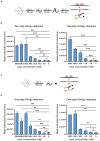Mesophilic Argonaute-based isothermal detection of SARS-CoV-2
- PMID: 35966688
- PMCID: PMC9363790
- DOI: 10.3389/fmicb.2022.957977
Mesophilic Argonaute-based isothermal detection of SARS-CoV-2
Abstract
Coronavirus disease (COVID-19), caused by SARS-CoV-2 infection and its mutations, has spread rapidly all over the world and still requires sensitive detection to distinguish mutations. CRISPR-based diagnosis has been regarded as a next-generation detection method; however, it has some limitations, such as the need for specific recognition sequences and multiple enzymes for multiplex detection. Therefore, research on the exploration and development of novel nucleases helps to promote specific and sensitive diagnoses. Prokaryotic Argonaute (Ago) proteins exert directed nuclease activity that can target any sequence. Recently, thermophilic Agos have been developed as new detection techniques achieving multiplexity for multiple targets using a single enzyme, as well as accurate recognition of single-base differential sequences. In this study, to overcome the requirement for high reaction temperature of thermophilic Ago-based methods, we expanded the mining of mesophilic Agos to achieve CRISPR-like isothermal detection, named mesophilic Ago-based isothermal detection method (MAIDEN). The principle of MAIDEN uses mesophilic Ago cleavage combined with reverse transcription, which can provide single-strand DNA as a substrate and allow cleavage of fluorescence probes to sense SARS-CoV-2 at moderate temperature. We first mined and optimized the mesophilic Ago and the fluorescence reporter system and then selected a compatible reverse transcription reaction. Furthermore, we optimized MAIDEN into a one-step reaction that can detect SARS-CoV-2 RNA at the nanomolar concentration at a constant temperature of 42°C within 60 min. Therefore, MAIDEN shows advantageous portability and easy-to-implement operation, avoiding the possibility of open-lid contamination. Our study was the first attempt to demonstrate that mesophilic Agos can be harnessed as diagnostic tools, and MAIDEN was easily extended to detect other pathogens in a rapid and efficient manner.
Keywords: RNA viruses; SARS-CoV-2; isothermal detection; mesophilic Ago; one-step method.
Copyright © 2022 Li, Dong, Guo, Huang, Xu, Li, Yang, Yao, Feng and Liu.
Conflict of interest statement
Shanghai Jiao Tong University has applied for a patent (application no. CN114277109A) for MAIDEN with QL, XL, YF, XG, and HD listed as co-inventors. The remaining authors declare that the research was conducted in the absence of any commercial or financial relationships that could be construed as a potential conflict of interest.
Figures




Similar articles
-
Mesophilic Argonaute-Based Single Polystyrene Sphere Aptamer Fluorescence Platform for the Multiplexed and Ultrasensitive Detection of Non-Nucleic Acid Targets.Small. 2024 May;20(20):e2308424. doi: 10.1002/smll.202308424. Epub 2023 Dec 11. Small. 2024. PMID: 38081800
-
Argonaute-integrated isothermal amplification for rapid, portable, multiplex detection of SARS-CoV-2 and influenza viruses.Biosens Bioelectron. 2022 Jul 1;207:114169. doi: 10.1016/j.bios.2022.114169. Epub 2022 Mar 18. Biosens Bioelectron. 2022. PMID: 35334329 Free PMC article.
-
Characterization of Argonaute nucleases from mesophilic bacteria Paenibacillus borealis and Brevibacillus laterosporus.Bioresour Bioprocess. 2021 Dec 19;8(1):133. doi: 10.1186/s40643-021-00478-z. Bioresour Bioprocess. 2021. PMID: 38650276 Free PMC article.
-
Toward a next-generation diagnostic tool: A review on emerging isothermal nucleic acid amplification techniques for the detection of SARS-CoV-2 and other infectious viruses.Anal Chim Acta. 2022 May 29;1209:339338. doi: 10.1016/j.aca.2021.339338. Epub 2021 Dec 1. Anal Chim Acta. 2022. PMID: 35569864 Free PMC article. Review.
-
Emerging Landscape of SARS-CoV-2 Variants and Detection Technologies.Mol Diagn Ther. 2023 Mar;27(2):159-177. doi: 10.1007/s40291-022-00631-0. Epub 2022 Dec 28. Mol Diagn Ther. 2023. PMID: 36577887 Free PMC article. Review.
Cited by
-
Prokaryotic Argonaute Proteins: A New Frontier in Point-of-Care Viral Diagnostics.Int J Mol Sci. 2023 Oct 8;24(19):14987. doi: 10.3390/ijms241914987. Int J Mol Sci. 2023. PMID: 37834437 Free PMC article. Review.
-
Characterization of argonaute nucleases from mesophilic bacteria Pseudobutyrivibrio ruminis.Bioresour Bioprocess. 2024 Oct 7;11(1):94. doi: 10.1186/s40643-024-00797-x. Bioresour Bioprocess. 2024. PMID: 39373873 Free PMC article.
-
Structural and mechanistic insights into a mesophilic prokaryotic Argonaute.Nucleic Acids Res. 2024 Oct 28;52(19):11895-11910. doi: 10.1093/nar/gkae820. Nucleic Acids Res. 2024. PMID: 39315697 Free PMC article.
-
Characterization of Argonaute Nuclease from Mesophilic Bacterium Chroococcidiopsis.Int J Mol Sci. 2025 Jan 27;26(3):1085. doi: 10.3390/ijms26031085. Int J Mol Sci. 2025. PMID: 39940853 Free PMC article.
-
Argonaute protein-based nucleic acid detection technology.Front Microbiol. 2023 Sep 8;14:1255716. doi: 10.3389/fmicb.2023.1255716. eCollection 2023. Front Microbiol. 2023. PMID: 37744931 Free PMC article. Review.
References
LinkOut - more resources
Full Text Sources
Miscellaneous

